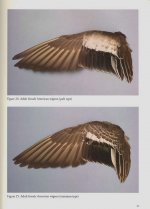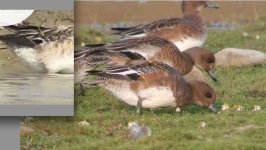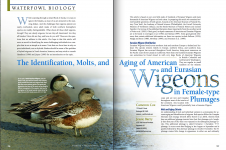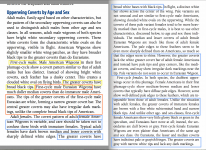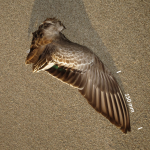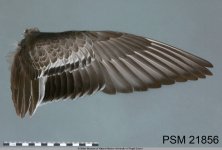Steve,
Interesting possible ID feature. Checking some of my references, both the Helm 'Bird Identification' guide and 'Advanced Bird ID Handbook' mention that the coverts of American Wigeon
tend to be paler than Eurasian Wigeon. The later reference also mentions that this is because the coverts have a white base and wider pale fringes, but also mentions the dark tip to the greater coverts, without being specific about whether this is an ID feature.
I think that possibly care is needed when looking at the greater coverts which are generally concealed in the closed wing. Looking at photographs of female American Wigeon open wings, I have found one photo where the inner 2 greater coverts do not appear pale with a dark tip, but dark grey with a narrow pale margin. As the inner greater coverts are the ones most likely to be exposed on the closed wing, I think that the true pattern on the feathers could be misinterpreted by looking at one or two feathers. On your photo of the bird with the black tips to the greater coverts, I note that the top feather although pale does not show the dark tip. The lower bird shows the three innermost greater coverts.
In the bottom two images in this link
American Wigeon (tsuru-bird.net (apparently of American Wigeons), the coverts look pale with wide fringes, but the dark tips are not apparent, even though one bird shows three and a bit of a fourth greater covert. The pale fringes to the coverts in the bottom bird are also noticeable thinner than the bird above, so some variation to the feathers.
To try to get a details description of the feathers I looked at 'Birds of the Western Palearctic' plumage section (an old reference, but detailed plumage descriptions should not change over time). For Eurasian Wigeon adult female it states '
Upper wing-coverts dark grey-brown, contrastingly edged white at tips, occasionally faintly barred and laterally suffused buff. Outer web of greater coverts tipped black (narrower than adult ♂), narrowly bordered white subterminally, often edged white at tip.' Interestingly for immature male it states '
Greater upper wing-coverts grey, outer webs with tip black, often narrowly bordered white' and for immature female '
Greater upper wing-coverts usually without dark blotch on white tip of outer web, but sometimes some black freckling'. I therefore wonder if the absence of the dark tip to the feathers is more of an ageing criteria for immature females?
That said, unless the image ifs effected by the harsh lighting, the video grab shows that the Mai Po bird has quite dark grey coverts with thin pale fringes, so more of a Eurasian Wigeon feature.





